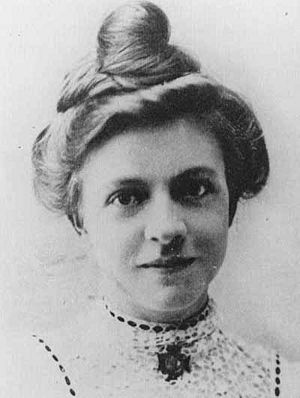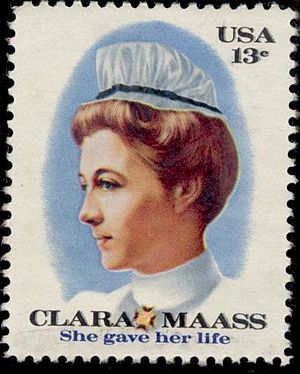Clara Maass facts for kids
Clara Louise Maass (June 28, 1876 – August 24, 1901) was an American nurse who died as a result of volunteering for medical experiments to study yellow fever.
Early life
Clara Louise Maass was born in East Orange, New Jersey, to German immigrants Hedwig and Robert Maass. She was the oldest of ten children in a devout Lutheran family. Clara's family was impoverished and to help alleviate the financial burden of one child on her family, she went to work as a "mother's helper" for a local woman while finishing high school after her family had failed in the farming industry. Her father had become a hatter and opened up a small grocery store to try to bring in more revenue. While she did not generate any income as a helper, she was still able to live and eat with her employer's family. Then at the age of 15, she began working at the Network Orphan Asylum, and two years later, at the age of 17, Maass started nursing school at the Christina Trefz Training School for Nurses after being influenced by Florence Nightingale.
In 1895, she became one of the first graduates of Newark German Hospital's Christina Trefz Training School for Nurses. By 1898, she had been promoted to head nurse at Newark German Hospital, where she was known for her hard work and dedication to her profession.
Army service
In April 1898, during the Spanish–American War, Maass volunteered as a contract nurse for the United States Army (the Army Nurse Corps did not yet exist), however, she was sent home because came down with dengue fever. She then served with the Seventh U.S. Army Corps from October 1, 1898, to February 5, 1899, in Jacksonville, Florida; Savannah, Georgia; and Santiago, Cuba. She was discharged in 1899, but volunteered again to serve with the Eighth U.S. Army Corps in the Philippines from November 1899 to mid-1900.
During her service with the military, she saw few battle injuries. Instead, most of her nursing duties came in providing medical aid to soldiers suffering from infectious diseases like typhoid, malaria, dengue and yellow fever. She contracted dengue in Manila, and was sent home.
She went back to serve for her country after hearing about the telegram from Major General William Gorgas had sent out asking for nurses to come to volunteer in Cuba.
Yellow fever studies
Yellow fever was an increasing problem in soldiers during the Spanish-American war, and it was the number one cause of death, along with malaria, and surpassed death by Spaniard soldiers on the battlefield and battle wounds.
Shortly after finishing her second assignment with the army, Maass returned to Cuba in October 1900 after being summoned by William Gorgas, who was working with the U.S. Army's Yellow Fever Commission. The commission, headed by Major Walter Reed, was established during the post-war occupation of Cuba in order to investigate yellow fever, which was endemic in Cuba. One of the commission's goals was to determine how the disease was spread: by mosquito bites or by contact with contaminated objects.
The commission recruited human subjects because they did not know of any animals that could contract yellow fever. In the first recorded instance of informed consent in human experiments, volunteers were told that participation in the studies might cause their deaths. As an incentive, volunteers were paid US$100 (approximately $4,000 today), with an additional $100 if the volunteer became ill.
In March 1901, Maass volunteered to be bitten by a Culex fasciata mosquito (now called Aedes aegypti) that had been allowed to feed on yellow fever patients; Out of 19 volunteers, she had been the only female and American to volunteer. Clara believed that this would help make her a better nurse since she would have a better understanding of what it is like to have the epidemic disease. By this time, the researchers were certain that mosquitoes were the route of transmission, but lacked the scientific evidence to prove it because some volunteers who were bitten remained healthy. Maass continued to volunteer for experiments and would send her mother all of the money she was given.
Maass was first bitten by mosquitoes in March of 1901, and then again in May, June, and finally in August. In those months she had come in contact with the yellow fever mosquitoes seven times. During her first bite, she had become ill but had only showed minor symptoms; This led researchers to believe that she was not immune, so they continued to research and test with Clara as their live subject. After the death of Clara Maass, researchers were now sure that the spread of the yellow fever disease was transmitted by mosquitos and felt that they could stop all human testing.
Death
On August 14, 1901, Maass allowed herself to be bitten by infected mosquitoes again. Researchers were hoping to show that her earlier case of yellow fever was sufficient to immunize her against the disease. Unfortunately, this was not the case. Maass once again became ill with yellow fever on August 18 after receiving her final infection and died on August 24 at the age of 25. She had sensed that something was different this time after becoming seriously ill, and she wrote her mother a goodbye letter days before her death. Her death roused public sentiment and put an end to yellow fever experiments on human beings. Because of her contributions, Clara became known as the woman who gave her life in the name of science. Upon passing, Maass was originally buried in the Colon Cemetery in Havana with military honors, but her body was then moved to Fairmount Cemetery in Newark, New Jersey, on February 20, 1902.
Once Maass' death was made public, newspaper headlines painted the story as something else. The headlines were saying that Clara had only been a part of the studies because she needed the money while others say that she did it for her mom and died because of it, and all of the claims upset her mother who claimed that what had happened to her daughter was short of murder.
Clara's work had gone unnoticed until Leopoldine Guinther, the superintendent of the hospital in Germany where Clara used to work, began to shed light on her story.
Legacy
Maass' work made it possible for the yellow fever vaccine to be made. The Cuban government placed a bronze plaque at the Las Animas Hospital in Havana, the hospital she had died at, to honor her sacrifice. In 1951, the 50th anniversary of her death, Cuba issued a postage stamp in her honour. On June 19, 1952, Newark German Hospital (which had since moved to Belleville, New Jersey) was renamed Clara Maass Memorial Hospital, and it is now known as Clara Maass Medical Center. In 1976, the 100th anniversary of her birth, Maass was honored with a 13¢ United States commemorative stamp. She was the first nurse honored with a stamp and additionally was also the first nurse to have a hospital named after them. Also in 1976, the American Nurses Association inducted her into its Nursing Hall of Fame. The Calendar of Saints of the Lutheran Church honors Maass and British nurse Florence Nightingale on August 13 as a "Renewer of Society."
See also
 In Spanish: Clara Maass para niños
In Spanish: Clara Maass para niños
- Unethical human experimentation in the United States



